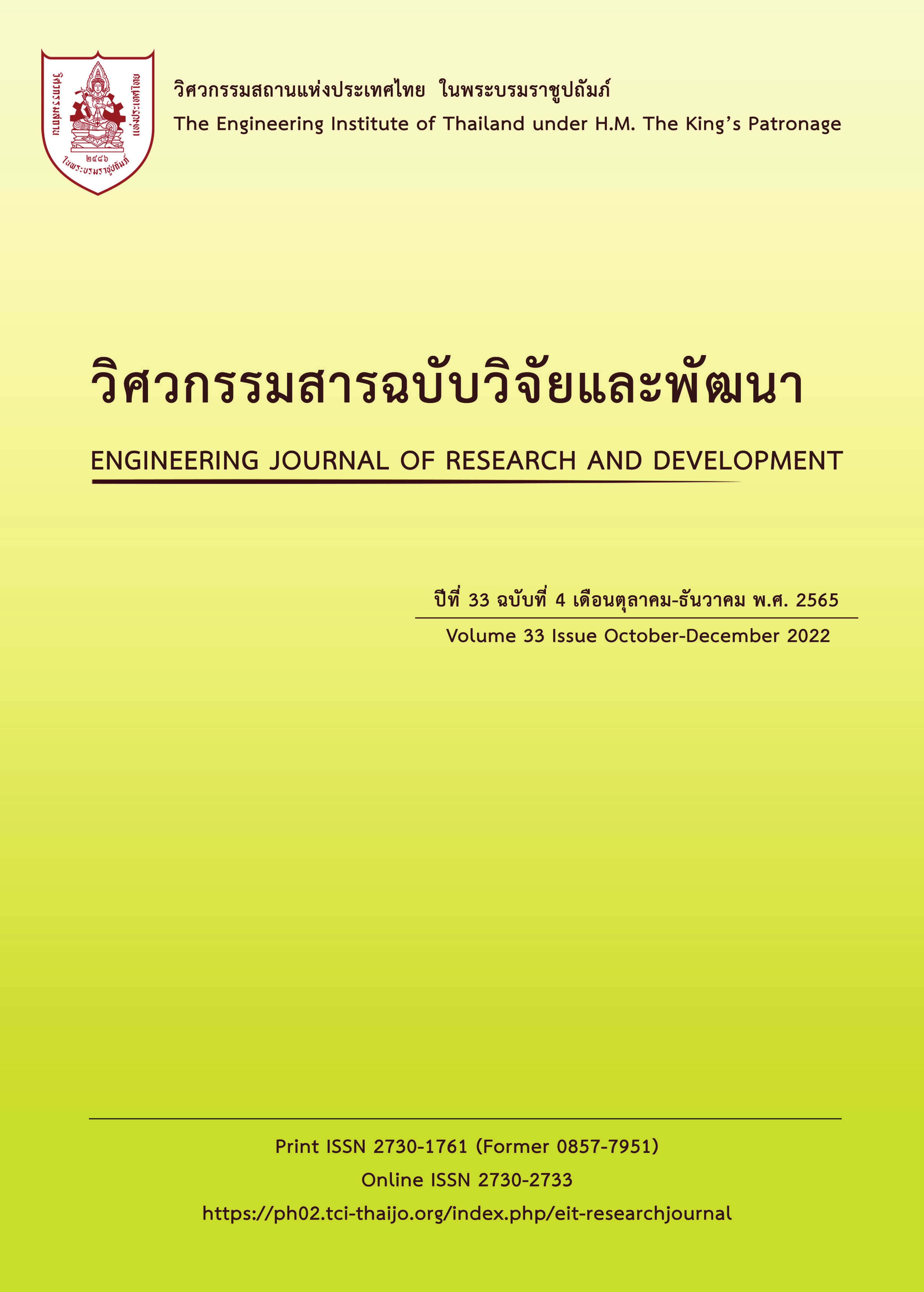SERVICEABILITY PERFORMANCE OF COMPOSITE METAL DECK WITH SLAB FROM RECYCLED CONCRETE COMPOSITION
Main Article Content
Abstract
This paper studies the serviceability performance of composite metal deck (2200x1000 mm) with slab from the recycled concrete aggregate. The composite metal decks with concrete made from recycled concrete aggregate (0-100% replacements) are metal deck slab-RCA0%, Metal deck slab-RCA25%, Metal deck slab-RCA50%, Metal deck slab-RCA75%, Metal deck slab-RCA100%. The specimens were tested in three testing series. In series 1, material proprieties of metal deck, FRP rods, as well as mechanical properties of RCA are investigated. In series 2, 15 test specimens were tested in short, 90 days long-term loadings and subjected to vibration due to human induction. In series 3, non-linear finite element analysis was used to study the ultimate capacity of test specimens with 100% reparent aggregate. Based on the result, it is found that the vibration levels recorded in the case of human walking lies within the acceptance level (<0.15g), except in the case of human jumping, which exceeds the very annoying level. Numerical results show that the failure mode for the tested slab with 100% RCA occurred due to metal deck yielding.
Article Details

This work is licensed under a Creative Commons Attribution-NonCommercial-NoDerivatives 4.0 International License.
The published articles are copyright of the Engineering Journal of Research and Development, The Engineering Institute of Thailand Under H.M. The King's Patronage (EIT).
References
Idrus, A. B. and Newman, J. B. Construction related factors influencing the choice of concrete floor systems. Construction Management & Economics, 2002, 20(1), pp. 13-19.
Mahmood, A. I. and Tsavdaridis, K. D. The evolution of composite flooring systems: applications, testing, modelling and eurocode design approaches. Journal of Constructional Steel Research, 2019, 155, pp. 286-300.
OHLSSON, S. Springiness and human-load floor vibrations. A design guide. Document-Swedish Council for Building Research, 1988.
Polensek, A. Structural damping and its effect on human response to floor vibrations. Forest Research Laboratory, Oregon State University, Corvallis, 1985.
Hu, J. L., Chui, Y. H., and Onysko, D. M. Vibration serviceability of timber floors in residential construction. Progress in Structural Engineering and Materials, 2001, 3(3), pp. 228-237.
Murray, T. M., Allen, D. E. and Ungar, E. E. Floor vibrations due to human activity Steel Des. Guid. Ser, 2003, 11, D811.
Mohammed, T. U., Hasnat, A., Awal, M. A. and Bosunia, S. Z. Recycling of brick aggregate concrete as coarse aggregate. Journal of Materials in Civil Engineering, 2015, 27(7), B4014005.
Dimitriou, G., Savva, P. and Petrou, M. F. Enhancing mechanical and durability properties of recycled aggregate concrete. Construction and Building Materials, 2018, 158, pp. 228-235.
De Brito, J., Ferreira, J., Pacheco, J., Soares, D. and Guerreiro, M. Structural, material, mechanical and durability properties and behaviour of recycled aggregates concrete. Journal of Building Engineering, 2016, 6, pp. 1-16.
De Brito, J., et al. Structural, material, mechanical and durability properties and behaviour of recycled aggregates concrete. Journal of Building Engineering, 2016, 6, pp. 1-16.
K. Jitchaiyapoom, S. Detphan, C. Detphan, T. Phoo-ngernkham, N. Damrongwiriyanupap and S. Hanjitsuwan. Mechanical Properties of High-Calcium Fly Ash Geopolymer and Normal Concretes using Recycled Concrete Aggregate Replaced Crushed Limestone. The Journal of KMUTNB, 2022, 32(3), (Accepted).
Setkit, M., Leelatanon, S., Imjai, T., Garcia, R. and Limkatanyu, S. Prediction of Shear Strength of Reinforced Recycled Aggregate Concrete Beams without Stirrups. Buildings, 2021, 11(9), pp. 402.
Imjai, T., Garcia, R., Guadagnini, M and Pilakoutas, K. Strength degradation in curved Fiber-reinforced Polymer (FRP) bars used as concrete reinforcement. Polymers, 2020, 12(8), pp. 1653.
ACI Committee 318-19. Building code requirements for reinforced concrete and commentary. American concrete institude: Detroit, 2019, pp. 417-463.
ASTM A370-12. Standard Test Methods and Definitions for Mechanical Testing of Steel Products. 2012.
ACI, A. 440.3 R-04. Guide Test Methods for Fiber-Reinforced Polymers (FRPs) for Reinforcing or Strengthening Concrete Structures. American Concrete Institute, Farmington Hills: USA, 2004.
ASTM C39/C39M-18. Standard Test Method for Compressive Strength of Cylindrical Concrete Specimens. Philadelphia: USA, 2001.
IGaging. Digital Dial Indicator, 2020. Available from: incrementaltools.com/iGaging_Digital_Dial_Indicator_p/iga-35-128.htm [Accessed 10 June 2020].
BS 6472-1. Guide to Evaluation of Human Exposure to Vibration in Buildings. Part 1: Vibration Sources Other Than Blasting, 2008.
ABAQUS. 2016. FEA software and User’s Manual version 6.14. Hibbitt, karlsson Sorensen Inc, Rhode Island: USA. http://www.abaqus.com, [1 March 2020]
Carreira, D. J. and Chu KH. Stress strain relationship for plaine concrete in tension. ACI Journal, 1985, pp. 82-72 : 797-804.
Kanhakorn, P., Rerksamosorn, W., Rerksamosorn, W., Inmontien, N., Imjai, T. and Setkit, M. Estimation of Shear behaviour for Recycled Aggregate Concrete using Digital Image Correlation (WU-DIC). The Journal of KMUTNB, 2021, 28(4).
Bulletin No. 56. Model Code 2010 - First complete draft, Volume 2, 2010. Available from: https://www.fib-international.org, 2020.
Bradford, M. A., Nethercot, D. and Trahair, N. Behaviour and design of steel structures to BS 5950. CRC Press. 2002.


